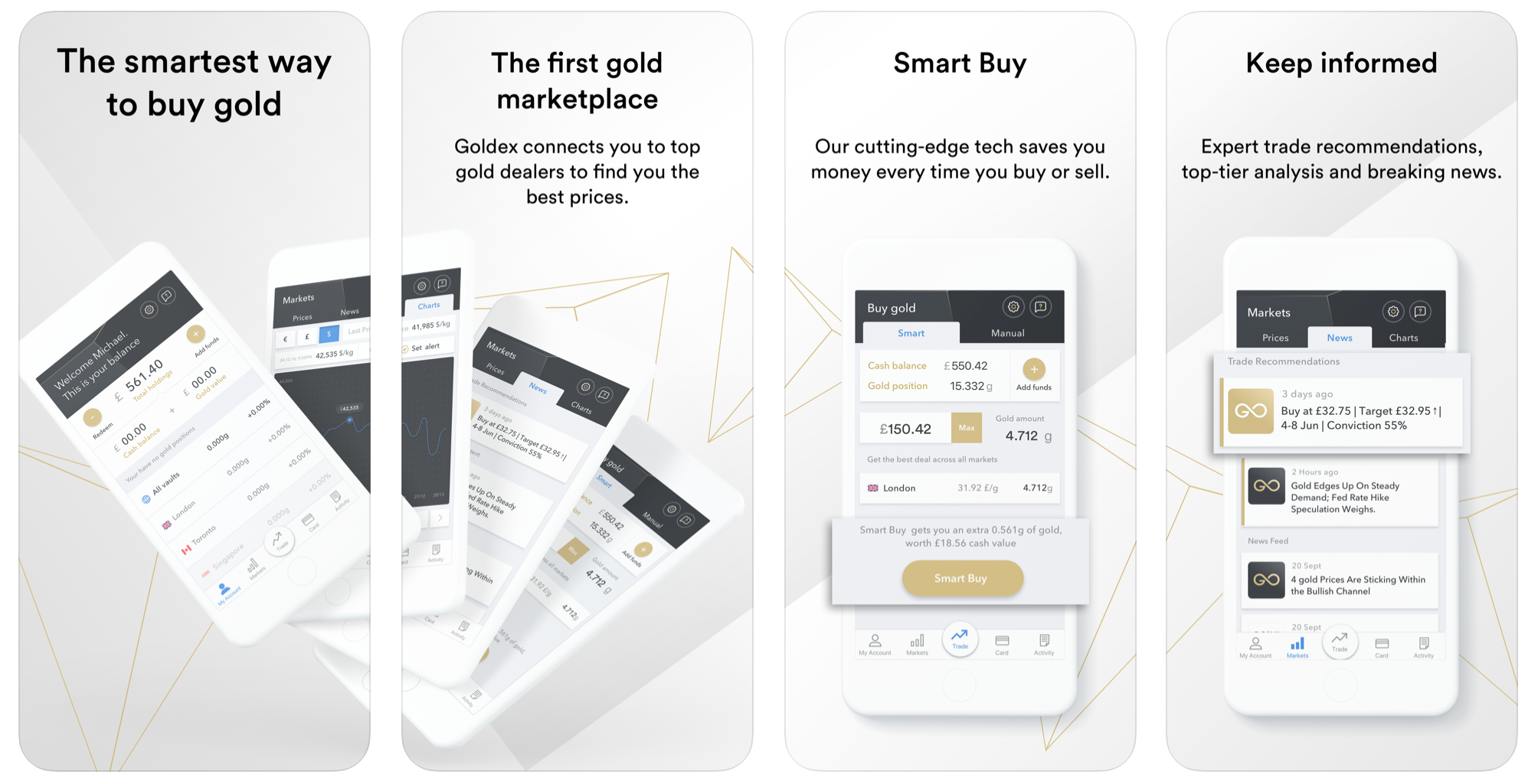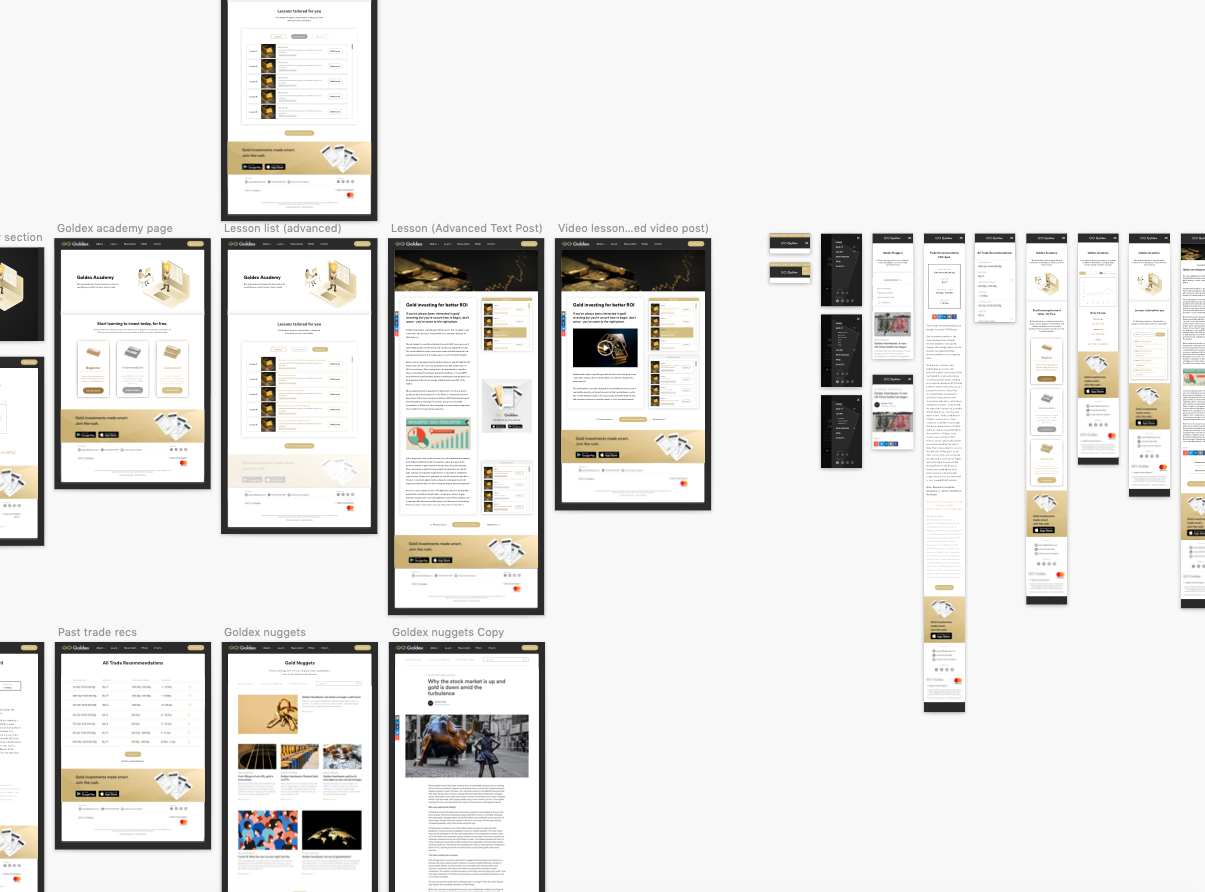Goldex
‘The first global gold marketplace powered by smart trading technology. Easily invest in physical gold and get the best price every time, whether you buy or sell. All gold is of the highest purity – responsibly sourced, insured and securely stored in professional vaults.’
My role
Lead UX / Design
Project types
UX
UI
Branding
Marketing Design
Duration
July 2019 - December 2021
Design tools
Sketch
Invision
Flowmapp
Overflow
Illustrator
Indesign
Photoshop
How it works
Goldex’s sophisticated trading algo finds best execution prices, from a 24/7 global marketplace.
You don’t need to be an expert to invest in gold. Goldex’s price charts, breaking news and trade recommendations make gold trading simple, clear and intuitive. Choose a milligram or a tonne; there’s no minimum investment.
The mission
Goldex provides a B2C and B2B2 service by enabling retail investors and institutions access to the world’s first allocated physical gold marketplace.
Gold is an OTC market which means there are multiple investment silos generated by gold dealers. Individuals and institutions who want to buy gold are exposed to inaccurate and unfair pricing.
The Goldex marketplace technology forces dealers to compete on pricing, making gold investing fairer for all.
My contribution
Reporting directly to the CEO I consistently generated user-centric design solutions.
I was in charge of the marketing design, retail mobile application and website development. I liaised with in-house and external developers by providing wireframes, UI, developer briefs and interactive prototypes.
Case Study: 'Goldex Academy'
Identifying the problem
The ‘Retail Gold Insights 2019‘ report published by the World Gold Council discovered that ‘65% of potential gold investors say they have gaps in their knowledge around gold; for example, they do not know what drives the price or feel that the process of buying is too difficult. There is clearly a scope to do more collectively as an industry to make it easier for investors to understand gold and the gold buying process.’
The report also concluded that ‘more than a quarter of those who have never previously invested in gold (but are considering doing so) worry about buying fake or counterfeit products’.
Lastly, the report stated that 28% of investors were worried ‘about buying fake or counterfeit gold’, 21% of investors said ‘The purity of the gold is not guaranteed, and 14% of investors said ‘I don’t trust the businesses selling the products’.
The strategy
It was clear to me that whilst product development and improving usability were important, that building trust with our retail clients was paramount.
Afer examining the World Gold Council’s findings, I established a strategy for the client research phase. It was time for Goldex to understand its clients.
I liaised with the Head of Operations by compiling a list containing the contact details of 100 of our clients – 50 clients who were our all-time most frequent traders, and 50 clients who had traded less than once per month for the past 6 months.
Gathering insights
As an incentive for each client providing 5 minutes of their time over the phone, I kindly explained that their account would receive 6 months of ‘free vaulting’ for answering a few simple questions. The questions were as follows:
Why did you initially invest in gold?
Has anything prevented you from investing in gold?
Where / who do you receive investment advice from?
What concerns did you / do you have when using our investment service?
Establishing insights
Of the 100 participants, 45 agreed to take part. Here were my findings:
Around 70% of participants were unsure of where they could receive consistent gold investment education.
Around 90% of participants originally invested in gold as they distrusted fiat currencies and / or considered gold a good hedge against inflation.
Around 5% of participants were currently investing in gold for alternative reasons e.g. as part of their retirement savings or to capitalise on short-term price movements.
And lastly, around 30% of participants did not fully trust digitised investment services.
The premise
As a result of my findings and in conjunction with the World Gold Councils insights it was clear that:
As a gold investment provider, we needed to be seen as experts in our industry.
That we needed to enable our clients to make educated investment choices.
That by doing both of the above we would gradually gain the trust of our clients (increasing client retention).
Research
I began my research by investigating existing financial education channels.
I analysed multiple sources such as The Financial Times, Investopedia, Babypips, and much more.
I also conducted competitor research and made note of the content structure, branding, copy, UI, and overall user experience.
It was clear to me that whilst most financial services provide educational resources for their clients, that fintechs operating within the gold industry were falling considerably short in comparison to their institutional counterparts.
Identifying opportunities / evaluating challenges
Below are some of the assumptions I made around opportunitied and challenges that our clients faced:
Opportunities
Individual learning types: Content provided should be categorised and tailored for experience levels.
Availability: educational content should be free and easily accessible for all of our clients. In accordance with the World Gold Council’s 7 Retail Gold Investment Principles ‘Fairness and integrity: ‘A provider must treat customers fairly and act with integrity, from information and service provision through to transaction completion’.
Incentivising clients: tracking progress, and providing rewards ecnourage clients to engage with the content.
Challenges
Accessibility: Ensuring that the clients’ are provided content that applies to their investment experience.
Gaining trust: We want to build a reputation for being honest, therefore we must ensure that we provide content which is fair, transparent, and non-biased.
Exploring the personas
Using the data from the client interviews I segmented and categorised clients.
As a result, three key personas were categorised:
The ‘I’m winging it’: those that have no experience in gold and limited knowledge of financial investments. Investing what they had spare to essentially gmable on the markets.
The ‘Dunning-kruger’: those that know just enough to think that they know a lot.
The ‘Calm and confident’: those with extensive first-hand investment experience.
Mapping opportunities and pain points
For the next phase of the project, I hosted a discovery workshop, where I encouraged the Head of Content and COO to identify opportunities and pain points that users could face whilst engaging with our educational material.
In chronological order, the user journey was mapped as follows:
Discover: The prospective client has identified they have a gap in their gold investment knowledge.
Explore: the prospective client explores the online educational content available to them.
Start course: the prospective client has chosen our content as a means of educating themselves about gold.
View content: the prospective client engages with our content.
Complete course: the prospective client has successfully engaged with all of the content.
Download the app: as a result, the prospective client has gained our trust and is engaging with our product.
Mapping user-flows
For the second phase of the discovery workshop, I encouraged the COO and Head of Content to help establish realistic design solutions and developer limitations.
User-flows and wireframes helped to define the content structure, site navigation, and explore solutions for a rewards systems.
Site mapping and Information architecture
As a result from the discovery workshop, a relatively simple site map was produced as a means of organising and presenting the high-level design requirements to the CEO.
Interactive protoypes and final designs
For the prototyping phase, I conducted in-house usability testing sessions by gathering valuable feedback from both the founders and internal app developers and external web developers.
Several design solutions were thoroughly explored which helped to identify the best solution.
Developing the designs
Hi-fi UI story designs were finalised and handed off to developers via Sketch alonge with interactive prototypes via Overflow.
A written brief which included functionality and feature specifications was provided for the external developers.
Liaising with the external web developers I ensured the brief was accurately fulfilled (via several rounds of UX QA) and that bugs were fixed for all responsive versions.
The Head of Content was briefed on the release of the Goldex Academy, and all relevant marketing collateral for the marketing campaign was deployed.
Results and takeaways
Since the development of Goldex Academy clients’ have had free access to a ‘world-class dedicated vault of expert-backed gold investment education’.
Additionally – being one of the greatest achievements – the Goldex Academy was the catalyst for the World Gold Council publicly acknowledging Goldex as one of the first businesses to adopt the ‘7 Retail Gold Investment Principles’ (read more here).
Key takeaways:
Be prepared to adapt the product: initial enthusiasm from founders backing the project can fall short when capital is limited. Be prepared to re-scope and lose a few features.
Everyone has a valid opinion: we all have unique experiences in life. Include all members of the team. It enables diverse range of feedback.
External developers need strong guidance: if you are not sat side-by-side then be prepared to conduct multiple rounds of development UX QA.
More of my work at Goldex
As is the case with being the only inhouse designer, I was also responsible for producing all visual assets which included advertisements (digital and print), user guides, user flows, market reports, and more.










